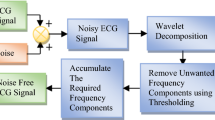Abstract
With the rapid development of medical imaging technology and artificial intelligence algorithms, cardiovascular monitoring systems have attracted more and more attention. The rapid progress and development of these cardiovascular monitoring technologies have provided a lot of help for the prevention and treatment of cardiovascular and cerebrovascular diseases. Research on cardiovascular monitoring systems has become an important topic. Therefore, this article designs a cardiovascular monitoring system based on medical imaging technology and artificial intelligence algorithms. This article introduces the ECG signal acquisition module and signal preprocessing module of the system in detail, and uses the wavelet decomposition algorithm in medical imaging technology to optimize the processing of the ECG signal. Aiming at the cardiovascular monitoring system designed in this article, this article has carried out targeted experiments. Experimental data shows that the standard deviation of systolic blood pressure measured by the sample machine is within 2.5, and the standard deviation of diastolic blood pressure is within 3.5. This shows that the system has high measurement accuracy.
Access this chapter
Tax calculation will be finalised at checkout
Purchases are for personal use only
Similar content being viewed by others
References
Xu, H., Liu, J., Zhang, J., et al.: Flexible organic/inorganic hybrid near‐infrared photoplethysmogram sensor for cardiovascular monitoring. Adv. Mater. 29(31), 1700975.1–1700975.6 (2017)
Surrel, G., Teijeiro, T., Chevrier, M., et al.: Event-triggered sensing for high-quality and low-power cardiovascular monitoring systems. IEEE Des. Test, 37(5), 85–93 (2019)
Lenz, A., Petersen, J., Riedel, C., et al.: 4D flow cardiovascular magnetic resonance for monitoring of aortic valve repair in bicuspid aortic valve disease. J. Cardiovasc. Magn. Reson. 22(1), 29 (2020)
Agarwala, R., Wang, P., Bishop, H.L., et al.: A 0.6V 785-nW multimodal sensor interface IC for ozone pollutant sensing and correlated cardiovascular disease monitoring. IEEE J. Solid-State Circ. 56(4), 1058–1070 (2021)
Luo, J., Zhen, J., Zhou, P., et al.: An iPPG-based device for pervasive monitoring of multi-dimensional cardiovascular hemodynamics. Sensors 21(3), 872 (2021)
Filippo, P.D., Malanchini, G., Ferrari, P.: Remote monitoring of cardiovascular implantable electronic devices: a valuable tool for a better care. Kardiol. Pol. 78(11), 1086–1087 (2020)
Rincon, J.A., Guerra, S., Carrascosa, C., et al.: An IoT and fog computing-based monitoring system for cardiovascular patients with automatic ECG classification using deep neural networks. Sensors 20(24), 7353 (2020)
Kapoor, A., Prakash, V., Sekhar, M., et al.: Monitoring risk factors of cardiovascular disease in cancer survivors. Clin. Med. (Lond.) 17(4), 293–297 (2017)
Fujiwara, T., Hoshide, S., Kanegae, H., et al.: Cardiovascular event risks associated with masked nocturnal hypertension defined by home blood pressure monitoring in the J-HOP nocturnal blood pressure study. Hypertension 76(1), 259–266 (2020)
Pena, M.J., Stenvinkel, P., Kretzler, M., et al.: Strategies to improve monitoring disease progression, assessing cardiovascular risk, and defining prognostic biomarkers in chronic kidney disease. Kidney Int. Supp. 7(2), 107–113 (2017)
Muniyappa, A., Judson, G.L., Shen, H., et al.: B-PO04-048 patient characteristics associated with adherence to remote monitoring of cardiovascular implantable electronic devices. Heart Rhythm 18(8), S298 (2021)
Cwh, A., Ssh, B.: Role of cardiovascular biomarkers in the risk stratification, monitoring, and management of patients with cancer. Cardiol. Clin. 37(4), 505–523 (2019)
Author information
Authors and Affiliations
Editor information
Editors and Affiliations
Rights and permissions
Copyright information
© 2022 The Author(s), under exclusive license to Springer Nature Switzerland AG
About this paper
Cite this paper
Ling, R., Jain, A. (2022). Cardiovascular Monitoring System Design Based on Medical Imaging Technology and Artificial Intelligence Algorithm. In: Xu, Z., Alrabaee, S., Loyola-González, O., Zhang, X., Cahyani, N.D.W., Ab Rahman, N.H. (eds) Cyber Security Intelligence and Analytics. CSIA 2022. Lecture Notes on Data Engineering and Communications Technologies, vol 123. Springer, Cham. https://doi.org/10.1007/978-3-030-96908-0_121
Download citation
DOI: https://doi.org/10.1007/978-3-030-96908-0_121
Published:
Publisher Name: Springer, Cham
Print ISBN: 978-3-030-96907-3
Online ISBN: 978-3-030-96908-0
eBook Packages: Intelligent Technologies and RoboticsIntelligent Technologies and Robotics (R0)




